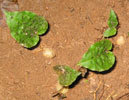|
|
|
|
|
| |
Flasks of
Tipularia discolor ("TD 5" group) -spontaneous |
|
| |
|
|
| |
| Number: |
TN3510 |
| Name: |
Tipularia discolor ("TD 5" group) -spontaneous
|
| |
Very low yield
|
| Type: |
spontaneous (What's that?) |
|
Click to Enlarge

Pod Parent Flowers |
Click to Enlarge

Pod Parent Inflorescences |
Click to Enlarge

Pod Parent Plants in Autumn |
|
|
|
| |
Comments: Commonly known as the "crippled cranefly orchid." The leaves, which appear in the fall and last until spring, are violet on the back side and sometimes marked with violet on the top side.
This North American native orchid is listed as threatened or endangered in some states. It is not on the Federal Endangered Species Act list. These are from North Carolina, where it is common, and the plants are growing on the donor's property. The North Carolina Dept. of Agriculture's Plant Conservation botanist has confirmed that seed collection is permissible. The states in which the plant is listed as threatened or endangered include but may not be limited to Florida, Pennsylvania, Massachusetts, Michigan and New York. You should check with your state about regulations regarding possession of the plants, and retain all paperwork to confirm the plants' origin.
Parent plant: The pale corms in the photo were exposed after a heavy rain, and are not normally visible.
|
About the name...
| Etymology of |
discolor |
|
From Latin "discolor" of different colors, variegated.
(Source:
Brown 1956) |
| Etymology of |
Tipularia |
|
From Latin "tipula" water-spider, but now applied to the cranefly.
(Source:
Brown 1956) |
| Pronunciation of |
discolor |
|
DIS-kol-or
(Source:
Hawkes 1978) |
| Pronunciation of |
Tipularia |
|
tip-yoo-LAH-ree-ah
(Source:
Hawkes 1978) |
|
If you would like to direct someone to this web page, please copy and paste this URL into your email:
http://troymeyers.com/d?013510
| Flask Information |
| Availability: |
We have sold all of the flasks for this item. |
| You should: |
Consider getting individual plants or compots instead of a flask.
You can place a "Notify Flask Recipients" Request, and either we or a flask recipient may contact you when plants are available.
You may also place a "Notify Retries" Request, and if an identical pollination (the same parents) is done again, we'll let you know.
You may reserve a flask, but it's very unlikely you'll get one ...this could only happen if we found a flask that we didn't know we had. |
| Yield Estimate: |
6 plants (based on flask surveys done 03/18/2004 )
|
| Plantlet Sizes: |
From many flasks 20 - 70 mm plants (based on flask surveys done 03/18/2004 )
From one most recently surveyed flask 20 - 70 mm (03/18/2004)
|
|
You might also want to:
|
View the seed assay for this item.
View items of the same species.
View items of the same genus.
|
| Ordering Information |
| You are not currently logged in. |
|
You must be a registered user and be logged in to reserve a flask or place a notification request. Please log in:
|
|
|
|
|
|
| |
|
|
| |
|
|
|